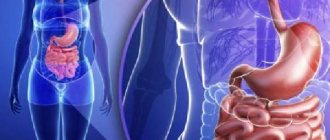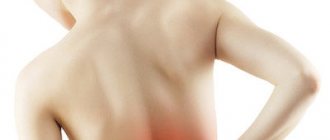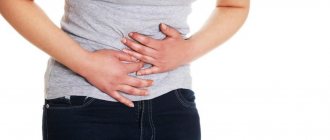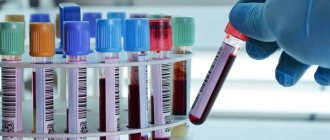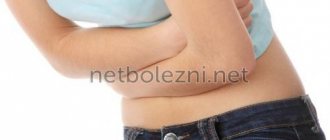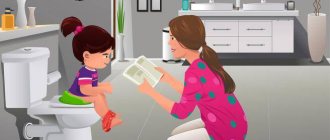BLOOD DURING DEFECATION AFTER CESAREAN SECTION.
Medical
Moscow, Bolshaya Molchanovka, building 32 building 1
e-mail; tel.: 8-910-434-17-86;
Sign up for a consultation: 8-926-294-50-03; (495)223-22-22.
The sphincter has nothing to do with it. It's called an anal fissure. And the reason for this is chronic constipation. Adjust your chair! Regulation of stool To regulate stool, in addition to diet (diet, table 3 for constipation, table 4 for diarrhea), for habitual constipation, the following medications are recommended: Duphalac, 15-20 ml daily or Forlax (Transipeg), 1 packet daily, or Mucofalk 3 -6 sachets daily, or Fitomucil 6 g daily, etc., of your choice. Dose selection is individual. As a rule, the dose can be reduced/increased after 2 days of use depending on need. The clinical effect occurs after 2 days. The dose or frequency of administration is increased if within 2 days of taking the drug there is no improvement in the patient’s condition in the form of normalization of stool. And don’t rush to the conclusion: “It doesn’t help!” This only means that the dose has not been selected. All medications are not absorbed, but act only in the intestinal lumen, therefore they are recommended for pregnant and lactating women. + Rezolor (Trimedat) - regulator of gastrointestinal motility, 200 mg x 3 times a day
Diet - table 3 according to Pevzner: - maximum inclusion in the diet of foods and dishes that have a beneficial effect on the functioning and emptying of the intestines (vegetables, fruits, bran); - exclusion from the diet of foods and dishes that lead to fermentation and rotting in the intestines - food preparation involves heat treatment (steaming, boiling or baking) Nature of nutrition: - up to six times a day - in the morning, preferably cold water with a spoonful of honey or juice fruit and vegetables - at night, kefir, prunes, compote using both dry and fresh fruits - fresh sweet fruits Drink up to 1.5 liters of water per day
source
Causes and stages of development of the disease during pregnancy
Hemorrhoids are a disease of the veins of the large intestine, the main manifestation of which is pouch-like dilatation of the vessels of the lower rectum. In the area of the anal canal in humans there are cavernous veins located directly under the mucous membrane. This type of vessel is characterized by a thin wall due to the absence of a muscular lining. The filling of cavities is significantly affected by blood pressure. When the outflow of blood is difficult, the veins of the rectal intestine expand, and when blood flow is restored, they narrow.
Increasing intra-abdominal blood pressure, including during pregnancy, leads to compression of the pelvic venous plexuses. It is in them that blood is evacuated from the cavernous veins. The vascular formations of the anal canal, equalizing the pressure, expand.
As the fetus grows, the number of blood vessels increases, and the volume of circulating blood in a pregnant woman increases. The load on the heart increases proportionally, causing stagnation of blood in the veins of the lower half of the body.
Prolonged congestion in the pelvic veins leads to the onset of the disease. A “bump” appears, which protrudes into the lumen of the anal canal. First it is inside the intestine - the first stage is internal hemorrhoids. If there are no complications, it is asymptomatic.
With ongoing constipation, which is often observed in pregnant women in the second and third trimester, the “bump” comes out during the act of defecation. After a few minutes, it returns inside the intestine. This is the second stage - combined (reducible) hemorrhoids. In the absence of stress or after sleep, the node “hides” in the intestinal lumen.
The longer the dilated cavernous vessels of the anal canal exist, the less opportunity there is to get rid of them. The walls become sclerosed (hardened), the veins no longer return to their original shape, and there is a feeling of a foreign body in the rectum. In the third stage, under no circumstances does the node return inside (irreducible hemorrhoids) .
At all stages of the disease, complications develop in the dilated cavernous vessels as a result of irritation by feces: inflammation of the rectum, thrombosis, necrosis and bleeding. The symptoms are dominated by pain, especially during bowel movements. Necrosis or thrombosis of the node is accompanied by constant cutting pain. The resulting cracks in the mucous membrane and the wall of the hemorrhoidal vein are manifested by bleeding. This may include streaks of blood in the stool, or prolonged bleeding from the anus.
A characteristic sign of bleeding from the lower intestines is scarlet blood, which does not undergo chemical transformations typical of “high” intestinal hemorrhage.
Causes of pain
During surgical childbirth, the abdominal muscles are injured. It takes time to restore them, and therefore in the first days after a cesarean section it is so painful for a woman to walk “in a big way”, because to perform the act of defecation, certain abdominal muscles need to be tensed.
Sometimes the problems are aggravated by the development of postpartum hemorrhoids, which can appear not only after a physiological birth, but also after a cesarean section, because it is not a consequence of the fact that the woman had to push during childbirth, but directly occurs due to pregnancy, when the lower veins, including hemorrhoidal, suffered from circulatory disorders and heavy uterine pressure.
All women are afraid to push after surgery. The fear that the stitches will come apart, as well as the fear of pain in the injured peritoneum, becomes a difficult obstacle to overcome in the task of normalizing stool. And this task is extremely important. The fact is that an overcrowded intestine due to constipation or an irritated intestine with loose stools can negatively affect the healing of internal sutures on the uterus and the contraction of the uterus to its previous size.
After the operation, under no circumstances should the intestines be overfilled or bloated, therefore, before surgery, the woman must undergo a cleansing enema, and after the operation she is prescribed a strict diet for two days.
Fear is the main cause of bowel movements after surgery. At the psychosomatic level, fear of possible pain and broken sutures causes spasm of the anal sphincter. As a result, it is impossible to go to the toilet when there is a great need.
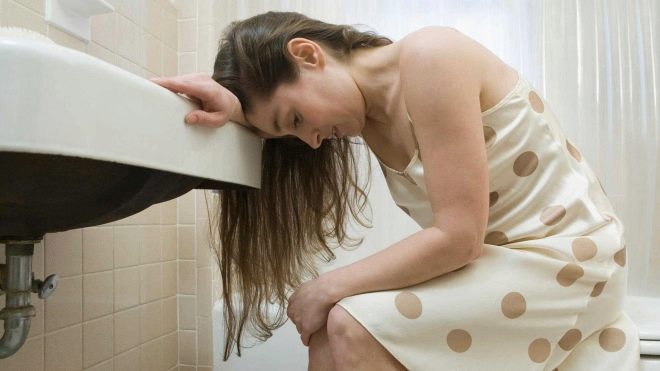
Causes of blood during difficult stools
Constipation occurs due to impaired functionality of intestinal motility and subsequent difficulty in bowel movements. If blood appears from the anus after constipation, it means that the integrity of the gastrointestinal tract lining is compromised or the vessels are damaged. Blood flows with constipation, which manifests itself chronically. A single defecation disorder does not provoke the appearance of blood and can only cause inflammation.
Causes:
- Inflammation in the abdominal cavity.
- The appearance of pathogenic microorganisms.
- Tumor formation.
- Thinning of the walls of blood vessels.
- Ulcer.
The secretion of blood in stool stuck in the intestines is dangerous. There may not be any blood on the toilet paper during a bowel movement, but symptoms of a serious illness may appear.
To avoid the risk of delaying the provision of necessary assistance, you need to visit a doctor. A hard lump of feces is examined by various tests. The location, quantity and color of feces, indicating various diseases, are taken into account.

The location of the blood is observed on the surface or can be distributed throughout the volume of the lump. The color is brighter the closer the source is to the anus. Red color indicates bleeding in the sigmoid colon. Brown color indicates large intestine.
Proctitis or colitis is diagnosed as a possible pathology. Bleeding in small quantities occurs due to tumors or cryptitis - blockage of the anal sinuses in the intestine. The result of bleeding is often the anus, which is injured by cracks.
Problems with urination
Pain and pain when going to the toilet “in a small way” can appear both in the first days after surgery and after discharge. The reason may lie in mechanical injury to the bladder during surgery (this does not happen often, but sometimes it does happen). Much more often, the cause of troubles with urination is a decrease in immunity, which is characteristic of all people after surgical operations.

Weak immunity cannot adequately repel pathogenic bacteria, and therefore cystitis occurs.
Cystitis can also be a reaction of the urinary tract to the insertion of a catheter, which is mandatory at the time of surgery and in the early postoperative period, when the postpartum woman cannot yet get up and go to the toilet on her own.
If a woman previously had problems with the kidneys or urinary tract, then after surgery, due to a decrease in immune defense, they may worsen, which will also manifest itself as a characteristic clinical picture - pain when urinating, changes in the color of urine, quantity, swelling, pain in the abdomen and lower back.
Common Causes of Constipation
- In the early postoperative period, intestinal paresis may occur (intestinal activity “freezes” and motor activity is limited). The intestines reflexively react in a similar way to any surgical manipulations on the abdominal organs, especially those performed under general anesthesia.
It is not difficult to recognize such intestinal paralytic obstruction - there is no discharge of gases or feces, asymmetrical bloating occurs, and cramping pain occurs. In the first three days after cesarean section, intestinal paresis does not cause concern.
Before childbirth, it is currently practiced to empty it of its contents using an enema, excluding food intake on the first day after surgery. If on the third day after a cesarean section there is no bowel movement, the doctor in the maternity hospital will prescribe a repeat enema.
- One of the complications that worsens intestinal motility after surgery on the abdominal organs is the formation of adhesions, like scars consisting of connective tissue between the organs located at the site of the operation. According to doctors, this process is a kind of protective reaction of the body to outside interference, and no one is immune from it.
Read also:
After childbirth, a woman’s lower abdomen hurts and should she worry?
The protective role of adhesions is to limit the spread of inflammatory reactions in the operated abdominal cavity. But, despite such a beneficial role of adhesive formation, their dense and inelastic structure disrupts the functioning of the pelvic organs. It is also possible that the intestinal loops “glue together,” which worsens its patency and increases the likelihood of constipation, bloating, and even diarrhea after cesarean section.
If all methods of normalizing stool after surgery are ineffective and are accompanied by painful sensations, then one can suspect the presence of a pronounced adhesive process that requires repeated surgical intervention. But we hasten to reassure you that such advanced adhesive formations are rare and are the result of a poorly performed caesarean section.
Ways to prevent this unpleasant phenomenon of “fusion” of organs are early physical activity in the postoperative period (6-8 hours after surgery) and physiotherapeutic procedures, which the doctor observing you can recommend while still in the maternity hospital.
- The tone of the abdominal muscles weakened by pregnancy, which occurs with any method of delivery, does not allow creating the intra-abdominal pressure necessary for the release of feces. In the case of a cesarean section, this problem is aggravated by a longer recovery period and a contraindication to physical activity of the problem muscles.
- Poor nutrition is perhaps the most important cause of constipation. Eating sandwiches on the run and washing them down with a cup of tea, in addition to the difficulties in the form of weakened muscles, sluggish intestinal motility, digestive problems will be added and going to the toilet will turn into torture.
Prevention
Since intestinal problems after surgery are common and common, doctors immediately warn the patient that she needs to get out of bed after surgery as soon as possible. There is no need to be afraid of pain, you need to move adequately to avoid such unpleasant complications as the formation of adhesions, intestinal paresis, and excessive relaxation.
7-8 hours after a cesarean section, a woman can turn to her side and make circular movements with her feet; after 10 hours, she can sit down and stand up. You need to walk carefully, holding your stomach with your hand. The process of acquiring physical activity can be facilitated by a special orthopedic postpartum bandage, which will carefully support relaxed and injured abdominal muscles.
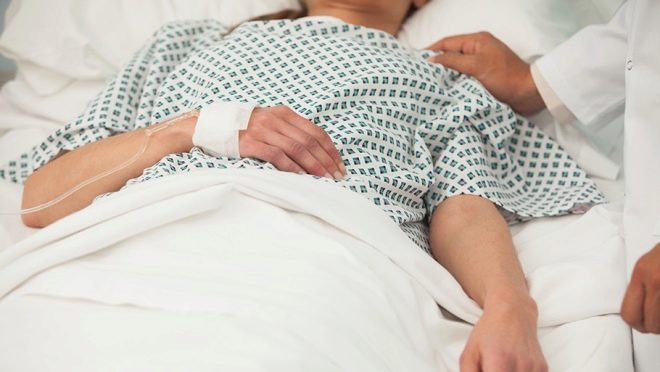
In order to improve bowel function, new foods must be introduced gradually after surgery. On the first day you can drink only water, and in the evening - a small amount of apple juice. On the second day, a woman can have chicken broth, provided that it is secondary, that is, cooked in second water. By the evening of the second day, a small amount of mashed potatoes without butter of a semi-liquid consistency is allowed. On the third day, a woman is allowed boiled and stewed vegetables, meat purees for baby food in jars, and cereal porridge.
You can switch to a full-fledged table, adapted for nursing mothers, from the fourth day after surgery.
It is important to drink enough liquid. It will be quite simple to restore the intestines if from the first days the woman follows all medical recommendations. The diet after discharge should contain enough coarse fiber, which is found in vegetables and fruits. Sugar, thick foods, large amounts of salt, foods with preservatives and dyes, legumes and cabbage, which cause increased gas, as well as carbonated drinks after cesarean section are prohibited.

Enemas and laxatives at home also should not be abused. With their use, the intestines become more “lazy” and the problem worsens. Such measures are good as one-time help for the intestines, but are unsuitable for systematic use.
Walking, moderate activity, and proper nutrition will help prevent constipation and diarrhea. If you have problems with “minor needs,” you should immediately consult a doctor.
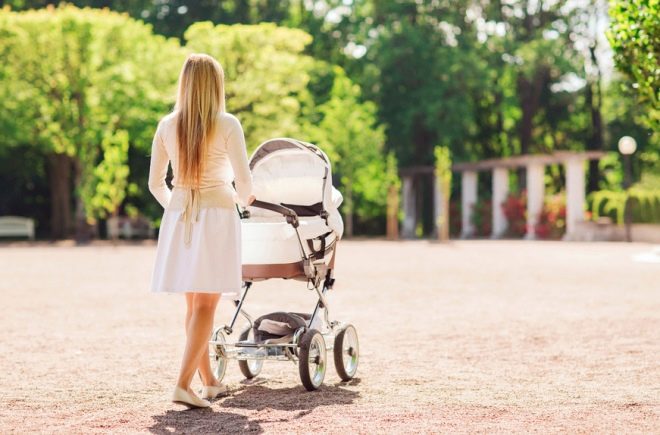
You will learn more about intestinal restoration after childbirth in the following video.
medical reviewer, psychosomatics specialist, mother of 4 children
source
How to eat properly to prevent constipation?
The benefits of fiber for the normal functioning of the digestive system and regular bowel movements have been proven. Fiber is a component of most plant foods. It is not broken down by the enzymes of the human body, but has a positive effect on intestinal motility and serves as food for the microflora inhabiting it.
Read also:
Causes of temperature after cesarean section
Once in the intestines, fiber absorbs liquid, toxins and other ballast, swells and gently removes this entire “cocktail” from the body. Therefore, when eating fiber, you need to drink at least 1.5-2 liters of liquid per day, which also has a beneficial effect on full lactation.
Fiber containing coarse plant fibers is best for combating constipation. It is found in bran from whole grains, bean husks, and the peels of vegetables and fruits. Vegetables and fruits with unpeeled skins should be eaten raw. Avoid plant foods that cause bloating - bananas, grapes, cabbage, legumes and dates.
Fermented milk products - yoghurt, fermented baked milk, kefir, low-fat cottage cheese - have a positive effect on the beneficial intestinal microflora.
Replace the usual pasta, rice and potatoes with buckwheat, millet, barley, and oatmeal.
Avoid baked goods and bread made from premium flour. Eat bread made from wholemeal flour with added bran.
It’s better to forget about kebabs, sausages, smoked meats, and fatty meats for a while.
If you have a very urgent situation, you can use laxative suppositories, for example, glycerin suppositories. An enema is not recommended, as it washes out the beneficial bacterial flora of the intestines, which has a detrimental effect on the digestive processes. Also, after consultation with a doctor, to normalize stool, it may be recommended to take lactulose-based laxatives that are harmless during breastfeeding.
You should not get carried away with laxatives. Otherwise, the effect will be the opposite of what was expected and you will get “lazy bowels.” It is advisable to use them only as a means of emergency assistance, while simultaneously organizing proper nutrition.
Proper nutrition for constipation - doctor's advice.
Alexander Shlychkov obstetrician-gynecologist
As soon as the child is born, the mother's uterus decreases in size, and the abdominal organs begin to get used to the new condition. Gynecologist Alexander Shlychkov talks about how to eat properly and what rules are best to follow in the first days after childbirth.
By the end of pregnancy, the intestines are in a compressed state. This significantly complicates the passage of food and may be one of the causes of constipation during pregnancy. Usually in the maternity hospital, women in labor are given cleansing enemas (to prevent involuntary emissions from the intestines during delivery). This is why women do not experience stool on the first or second days after childbirth. If a woman was not prepared in this way, she did not have any enemas, then her intestines begin to work immediately after childbirth as usual.
Do hemorrhoids develop after cesarean section?
Acute hemorrhoids are an exacerbation of a chronic disease. Therefore, the answer to the question of whether there can be hemorrhoids after cesarean section is simple: no, the disease cannot occur. It can only get worse. This means that you already had hemorrhoids, you did not notice them or ignored them, but something (surgery, stress, constipation, poor hygiene) aggravated the disease. And this needs to be clearly understood: it was not the caesarean section that caused the sudden illness, but some factor due to the characteristics of this period of life that led to an exacerbation of the disease you already had.
Natural childbirth
If during childbirth a woman has tears in the vagina, or she has had an episiotomy (dissection of the tissue of the perineum), doctors cannot do without stitches. spastic constipation is most often observed : the intestines are in a compressed state, sometimes accompanied by abdominal pain.
- A young mother should not sit (only stand or lie down); it is also not recommended to push.
- Take antispasmodic drugs.
- Follow a special diet that improves intestinal motility.
conclusions
Caesarean sections are not performed for hemorrhoids: the only exceptions are those cases where the hemorrhoids are complicated and the risk of bleeding in the woman in labor is high. Stage 1 hemorrhoidal disease, which often accompanies pregnancy, is not a contraindication to natural childbirth.
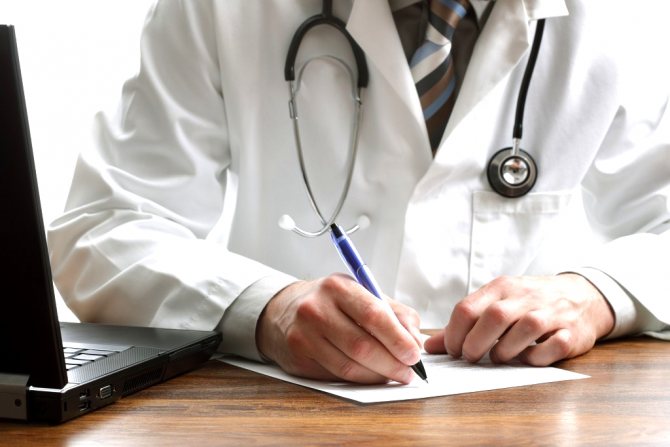
Hemorrhoids can and should be treated both during pregnancy and after childbirth. Those women who refuse gentle and safe treatment for hemorrhoids for the entire 9 months and wait until the end of lactation to treat the disease properly are mistaken. By this time, hemorrhoids may progress so much that when you visit a proctologist, you will leave with a referral for surgery.
And most importantly: only the doctor decides how to treat hemorrhoids after a cesarean section. Neither your roommates, nor your mother, nor an online forum can diagnose you and prescribe treatment regimens. Be conscious, reasonable and prudent. React to negative symptoms in a timely manner, and then your baby’s wonderful time of infancy will not be overshadowed by mother’s illnesses and ailments.
The pain of pregnancy and childbirth via cesarean section was left behind - the baby was born, but hemorrhoids developed.
At risk are women after childbirth or cesarean section. Thrombosis gradually develops, starting from the second trimester, when bearing a child becomes difficult.
Internal hemorrhoids are formed due to strong pressure of the uterus on the muscles, intestinal vessels - on the veins of the rectum - and frequent constipation. During childbirth, patients with lesions of the anus and anal area are likely to experience hemorrhoidal cones due to increased physical stress on the body.
Doctors carefully check for the presence of hemorrhoidal symptoms in pregnant women during the acute stage of the disease. Sometimes this cannot be done before surgery. Therefore, women in labor are interested in the treatment of hemorrhoids after cesarean section.
Diet after childbirth
In the first days, a woman’s diet should consist only of liquid food: still mineral water in large quantities, broths. Then, gradually, the young mother should switch to more solid foods, limiting the consumption of bread and flour products.
The main thing is that the food contains a large amount of fiber - it actively helps the intestines work and eliminates problems with stool. As you know, fiber is found in vegetables and fruits. Considering that almost all women breastfeed their babies, and it is extremely important not to cause allergies in the baby, choose “universal” fruits and vegetables. Moreover, this list may change depending on the season.
Vegetables and fruits, universal for nursing and non-breastfeeding mothers:
- Zucchini, pumpkin, broccoli, boiled carrots, eggplant, beets.
- Apples, pears, bananas, plums, currants, gooseberries, cherries.
Figs and prunes have a beneficial effect on intestinal function in the first days after childbirth (but you should be extremely careful with plums). And also olive or sunflower oil (1 tbsp per day). It is worth reassuring nursing mothers suffering from constipation: an imbalance in intestinal function does not affect the quality of breast milk.
And non-breastfeeding mothers can resume their normal diet within a week after giving birth.
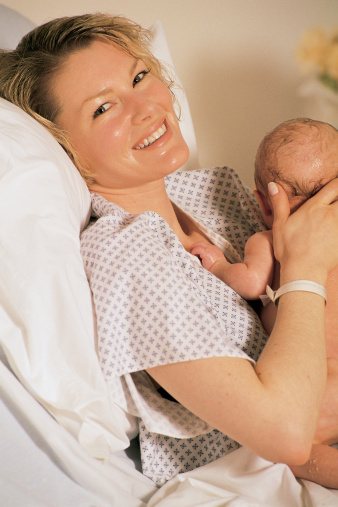
, constipation due to fear is common . Until the stitches heal, the young mother thinks that something might happen during a bowel movement. This is not true: if doctors performed an operation and stitched for 6 days, this does not mean that you have to endure it and not go to the toilet until everything heals! If a woman cannot cope with her fears, nurses in the maternity hospital will help give a cleansing enema.
What to do with blood in stool after childbirth?
If you had problems with bowel movements or experienced constipation or loose stools before giving birth, then after birth you need to carefully monitor the changes occurring in the body. Is there still constipation? Is there blood in the stool? What color is this blood, and what is its volume in the stool (spots, threads, liquid scarlet blood)?
It is very important to know what color the blood comes out. If it is bright scarlet, then most likely, along with hemorrhoids, you have anal fissures
But if the stool contains dark blood, then the hemorrhoid itself was probably damaged. Even among doctors, blood in these cases is the most important indicator for making a diagnosis.
In order to restore damaged intestines after childbirth, relieve constipation and forget about bloody stools, you can use some folk remedies.
Firstly, it is important to ensure softness and good passage of stool. To do this, you should eat various vegetable oils, as well as foods rich in fiber (dried apricots, raisins, nuts, fresh vegetables)
You can add mild laxatives to this; they will quickly and effectively make stool more liquid. After such simple treatment, constipation should stop.
You can lubricate the anus with such vegetable oils - this will help heal microcracks and make the intestinal walls more elastic. To relieve pain, special anesthetic suppositories are recommended, which are sold in pharmacies (Asklezan). They are approved for nursing mothers and can stop bleeding.
Medicinal suppositories like Gepatrombin will help a lot. Some doctors even recommend smearing the anus with ointments that are advertised for varicose veins in the legs (for example, troxevasin).
If a woman is constipated, it is a good idea to self-massage the abdomen in a clockwise direction.
When there is blood in the stool, it is important to immediately calm the blood vessels in order to remove this blood. It would be a good idea to use very soft toilet paper and wash with very cool water.
This stops the bleeding.
Unfortunately, bloody stool and constipation in women who have recently given birth are far from uncommon. In order to protect yourself from such manifestations, you should worry about your health in advance. Even while planning pregnancy or after it begins, you should visit the pool, do simple physical exercises, and smear your limbs (and anus, if you have a tendency to varicose veins) with special ointments that improve vascular tone.
During pregnancy, a woman treats her health with increased attention and vigilance, since her main desire is the birth of a healthy baby. During pregnancy, one of the most common phenomena is the appearance of problems with the intestines and rectum, which many women are embarrassed to talk about
If we are talking about constipation or diarrhea, then the expectant mother can completely cope with this problem on her own. However, if the stool becomes an unusual color or blood appears in it, then this may be a sign of the development of a dangerous disease in the body of a pregnant woman and it is necessary to inform the doctor about such a problem.
Normal feces during pregnancy are an indicator of the functioning of the liver, which during this period works with increased load. The preservation of feces depends on the liver, but its smell and consistency can change significantly, since most women take various multivitamin complexes during pregnancy. Most of them contain a trace element such as iron, which has a significant effect on changing the color of stool and gives it a dark color.
Many experts believe that stool turns black because the body is ridding itself of excess iron. Of course, the body absorbs the required amount of this microelement, but it gets rid of excess in this way. It is for this reason that women during pregnancy should not have concerns about dark or even black stool.
In the event that taking various vitamin complexes during pregnancy is not accompanied by a change in the color of the stool, then this only confirms their quality
During pregnancy, it is necessary to pay increased attention to your health and, in case of any unusual or painful condition, report it to your doctor.
C-section
A caesarean section has a worse effect on the functioning of the intestines than a natural birth, since during the operation the woman is given a certain drug that “inhibits” the functioning of the intestines. This causes atonic constipation . For atonic constipation, a certain drug is used that stimulates intestinal function.
As a consequence and extreme degree of atonic constipation, a woman may experience bloating and bloating. This happens if the uterus ruptures during childbirth, or if the woman in labor had peritonitis.
Sometimes complications caused by a long stay under anesthesia contribute to the occurrence of atonic constipation. But now Russian clinics are pursuing a policy aimed at ensuring that young mothers immediately begin to move actively after giving birth: this affects the functioning of the intestines - it begins to function much better. So, hours after a caesarean section, the woman is asked to get up and walk around - more and more every day.
How constipation harms the body
Constipation is a direct path to diseases such as hemorrhoids and anal fissures. In addition to all other “pleasures”, intoxication of the body is added.
After all, feces contain many poisons, and lingering in the intestines for more than 48 hours, toxins enter the bloodstream and poison the entire body.
There is an increased load on the liver, which affects general well-being and appearance. Feeling tired, headaches, skin becomes pale and dry, and hair begins to fall out. This condition cannot but affect the baby if you are breastfeeding.
Read also:
Lactostasis during breastfeeding
Problems with stool are common companions for women who have undergone a cesarean section. We hope that our article has at least somehow helped you in understanding the essence of the phenomena happening to you and solving such a delicate problem.
Causes of hemorrhoids before delivery
The development of pregnancy contributes to a significant increase in the size of the uterus. An enlarged uterus puts increased pressure on all internal organs and veins in the intestinal area. Such pressure provokes venous expansion in the lower intestine, promotes the accumulation of blood in the veins and leads to pathology. Inflammation of hemorrhoids is also caused by hormonal changes in the female body, weakening of its protective properties, and changes of a psychological nature.
Hemorrhoids are a common disease among pregnant women. It mainly occurs in pregnant women who have the prerequisites for its formation even before the birth of the fetus. Pregnancy only makes it worse.
The reasons for the appearance of this pathology during pregnancy include:
- regular defecation delay;
- diseases of the vascular system;
- genetic predisposition;
- gastrointestinal pathologies;
- pinching of intestinal vessels.
Return to contents
Why is it dangerous?
For a postpartum woman after surgery, any disease is dangerous due to the fact that her immunity is greatly reduced. Postoperative rehabilitation requires a lot of strength and energy from the body, no less is required to establish and maintain normal, full lactation.
Hemorrhoidal anal bleeding, which often accompanies the appearance of nodes, is dangerous for the development of anemia, which will negatively affect both the woman and the baby.

Cracks in the anus and rectum contribute to infection and the development of a bacterial infection. In addition, the symptoms themselves cause the new mother a lot of physical and psychological suffering, which does not have the best effect on lactation, mood, and well-being. A child who consumes a large amount of stress hormones through the breast milk of a suffering mother is also worried.
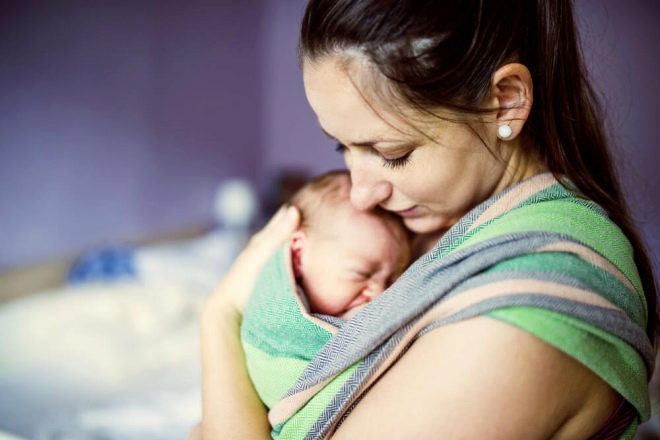
It is usually believed that hemorrhoids appear mainly only in those women who have given birth naturally. The attempts were not in vain, and their unpleasant consequences make themselves felt in the very first days after the birth of the baby.
We recommend reading: Pimples on the scalp in the hair of men and women: causes, treatment, how to get rid of them in adults and children and prevent recurrence
But in this article we will talk about hemorrhoids after cesarean section, during which there was no pushing. Is this true or a myth, is this possible and what reasons can cause this delicate illness?

Is hemorrhoids an indication for cesarean section?
The indication for cesarean section for hemorrhoids in the initial stages is not mandatory. Natural labor attempts and the movement of the fetus along the birth canal increase intra-abdominal pressure, straining the abdominal muscles and squeezing the intestinal veins. Hemorrhoids complicate childbirth, increase its pain and duration. Despite such a complex birth process, natural delivery is safe for the baby and contributes to the rapid rehabilitation of the woman in labor.
If severe complications develop, a cesarean section for hemorrhoids is mandatory. The main indication for its use is grade 4 hemorrhoids. Natural childbirth at this stage of the disease is dangerous, because during labor, the nodes, overflowing with blood from high pressure, rupture and bleed profusely. Rapid contraction of the anal muscles provokes compression of the nodes and their prolapse outward.
Abdominal surgery is performed if the following signs of illness are present:
- blockage of nodes;
- the presence of pathogenic bacteria and fungi;
- prolonged and heavy bleeding;
- necrosis of tissues of the gastrointestinal tract.
The use of cesarean section for hemorrhoids:
- prevents increased pressure during childbirth on internal organs and blood vessels;
- prevents the worsening of the pathological condition;
- prevents blood stagnation.
Return to contents
Causes
After surgery for cesarean section, there is a high risk of hemorrhoids. This is due to the fact that dilation of blood vessels in the rectum develops in most women during pregnancy.
Indeed, during pregnancy, a woman’s body undergoes increased stress, which adversely affects the condition of blood vessels.
During the postpartum period, with a cesarean section, women should be in a supine position on the first day. This leads to stagnation of blood in the pelvic organs and overfilling of blood vessels, and accordingly, an exacerbation of the disease occurs.
During cesarean delivery, adynamia increases the likelihood of developing constipation. This is also a predisposing factor to exacerbation of hemorrhoids, especially after cesarean section.

During cesarean delivery, adynamia increases the likelihood of developing constipation. This is also a predisposing factor to exacerbation of hemorrhoids.
